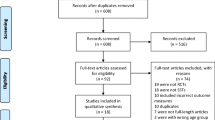Abstract
We retrospectively analyzed data from a pilot study that examined the impact of the Internet-based Parent-implemented Communication Strategies (i-PiCS) program (Meadan et al. in Journal of Early Intervention, 2016) on two families whose children primarily used unaided augmentative and alternative communication (AAC). The purpose of this analysis was to explore possible explanations for discrepant findings between behavioral data and social validity data in single-case research. These divergent findings were revealed when we attempted to mix two methods to make assertions about intervention effectiveness. Guided by two hypotheses, we recoded the original pilot study video recordings by introducing new dependent variables that were linked to information gleaned from the social validity assessment (i.e., self-reports by the parents and interventionist). After assessing these new dependent variables, we found support for improvement produced by the i-PiCS program that had not been identified in the original observational recording. We present the methods and results of this secondary analysis and discuss the potential value of using mixed methods to combine observational behavioral data with self-report social validity data in behavioral research.









Similar content being viewed by others
Notes
We recognize that we are referring to two different methodologies by referencing quantitative single-case research and qualitative inquiry. However, we use “methods” throughout the manuscript because “mixed methods” is used to describe the mixing of both methods and methodologies.
We recognize that other potential explanations exist (e.g., measurement error), but we focused our investigation on these.
References
Centers for Disease Control and Prevention (2013). New data on autism spectrum disorders. Retrieved from http://www.cdc.gov/Features/CountingAutism/.
Creswell, J. W., & Plano Clark, V. L. (2011). Designing and conducting mixed methods research (2nd ed.). Thousand Oaks: Sage.
Forget-Dubois, N., Dionne, G., Lemelin, J.-P., Pérusse, D., Tremblay, R. E., & Boivin, M. (2009). Early child language mediates the relation between home environment and school readiness. Child Development, 80(3), 736–749. doi:10.1111/j.1467-8624.2009.01294.x.
Frost, L., & Bondy, A. (2002). PECS: The picture exchange communication system training manual (2nd ed.). Cherry Hill: Pyramid Educational Consultants.
Greene, J. C. (2007). Mixed methods in social inquiry. San Francisco: Jossey-Bass.
Hancock, T. B., & Kaiser, A. P. (2006). Treatment of language disorders in children. In R. J. McCauley & M. E. Fey (Eds.), Enhanced milieu teaching (pp. 203–236). Baltimore: Brookes.
Hart, B., & Risley, T. R. (1975). Incidental teaching of language in the preschool. Journal of Applied Behavior Analysis, 8(4), 411–420.
Kaiser, A. P., & Roberts, M. Y. (2013a). Parent-implemented enhanced milieu teaching with preschool children who have intellectual disabilities. Journal of Speech, Language, and Hearing Research JSLHR, 56(1), 295–309. doi:10.1044/1092-4388(2012/11-0231).
Kaiser, A. P., & Roberts, M. Y. (2013b). Parents as communication partners: an evidence-based strategy for improving parent support for language and communication in everyday settings. Perspectives on Language Learning and Education, 20(3), 96–111. doi:10.1044/lle20.3.96.
Kazdin, A. E. (2011). Single-case research designs: Methods for clinical and applied settings (2nd ed.). New York: Oxford University Press.
Law, J., Rush, R., Schoon, I., & Parsons, S. (2009). Modeling developmental language difficulties from school entry into adulthood: literacy, mental health, and employment outcomes. Journal of Speech, Language, and Hearing Research, 52, 1401–1416.
Leffel, K., & Suskind, D. (2013). Parent-directed approaches to enrich the early language environments of children living in poverty. Seminars in Speech and Language, 34(4), 267–278.
Meadan, H., Meyer, L. E., Snodgrass, M. R., & Halle, J. W. (2013). Coaching parents of young children with autism in rural areas using internet-based technologies: a pilot program. Rural Special Education Quarterly, 32(3), 3–10.
Meadan, H., Angell, M. E., Stoner, J. B., & Daczewitz, M. E. (2014). Parent-implemented social-pragmatic communication intervention: a pilot study. Focus on Autism and Other Developmental Disabilities, 29(2), 95–110. doi:10.1177/1088357613517504.
Meadan, H., Snodgrass, M. R., Meyer, L. E., Fisher, K. W., Chung, M. Y., & Halle, J. W. (2016). Internet-based parent-implemented intervention for young children with autism: A pilot study. Journal of Early Intervention (in press).
Meline, T., & Paradiso, T. (2003). Evidence-based practice in schools. Language, Speech, and Hearing Services in Schools, 34(4), 273–283. doi:10.1044/0161-1461(2003/023).
Odom, S. L., Collet-Klingenberg, L., Rogers, S. J., & Hatton, D. D. (2010). Evidence-based practices in interventions for children and youth with sutism spectrum disorders. Preventing School Failure Alternative Education for Children and Youth, 54(4), 275–282. doi:10.1080/10459881003785506.
Parker-McGowan, Q., Chen, M., Reichle, J., Pandit, S., Johnson, L., & Kreibich, S. (2014). Describing treatment intensity in milieu teaching interventions for children with developmental disabilities: a review. Language, Speech, and Hearing Services in Schools, 45(4), 351–364. doi:10.1044/2014_LSHSS-13-0087.
Snell, M. E., & Brown, F. (2011). Instruction of students with severe disabilities (7th ed.). Boston: Pearson.
Stoner, J., Meadan, H., & Angell, M. E. (2013). A model for coaching parents to implement teaching strategies with their young children with language delay or developmental disabilities. Perspectives on Language Learning and Education, 20(3), 113–119. doi:10.1044/lle20.3.112.
Wainer, A. L., & Ingersoll, B. R. (2013). Disseminating ASD interventions: a pilot study of a distance learning program for parents and professionals. Journal of Autism and Developmental Disorders, 43(1), 11–24. doi:10.1007/s10803-012-1538-4.
Wolf, M. M. (1978). Social validity: the case for subjective measurement or how applied behavior analysis is finding its heart. Journal of Applied Behavior Analysis, 11, 203–214.
Zimmerman, I. L., Steiner, V. G., & Pond, R. E. (2012). Preschool language scale (5th ed.). San Antonio: Harcourt Assessment.
Author information
Authors and Affiliations
Corresponding author
Ethics declarations
Funding
This project was supported in part by funding from the Office of Special Education Programs, U.S. Department of Education: Project LEAD (H325D100062).
Ethical Approval
All procedures performed in studies involving human participants were in accordance with the ethical standards of the institutional and/or national research committee and with the 1964 Helsinki declaration and its later amendments or comparable ethical standards.
Informed Consent
Informed consent was obtained from all individual participants included in the study.
Rights and permissions
About this article
Cite this article
Chung, M., Snodgrass, M.R., Meadan, H. et al. Understanding Communication Intervention for Young Children with Autism and Their Parents: Mixing Behavioral and Social Validity Findings. J Dev Phys Disabil 28, 113–134 (2016). https://doi.org/10.1007/s10882-015-9468-7
Published:
Issue Date:
DOI: https://doi.org/10.1007/s10882-015-9468-7




